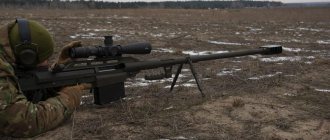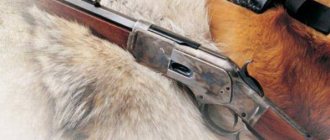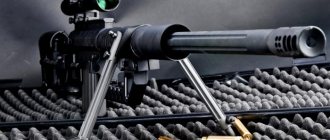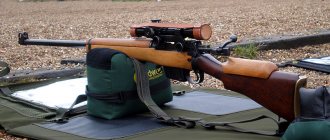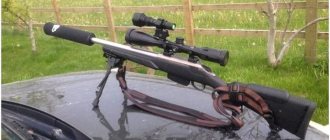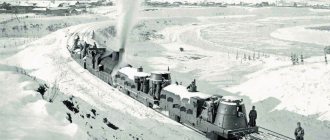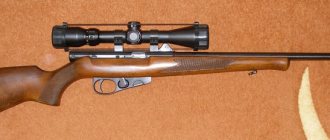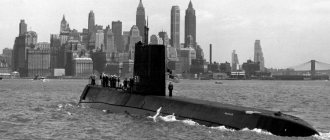Author: Dragon
November 28, 2022 11:20
Community: Military
Tags: weapons retro photos old photos
4124
45
General Mondragon's self-loading rifle went down in history as the first “automatic” rifle officially adopted for service. And this happened a hundred years ago - in 1908, “The first swallow” became, rather, “the first pancake,” and he, as the saying goes, “is always lumpy.” Nevertheless, the biography of this rifle reflected a number of interesting and important moments in the development of automatic small arms of that time.
0
See all photos in the gallery
Mexican soldier with Mondragon rifle
The emergence of automatic rifles
In the second half of the 19th century. the introduction of cast steels, cartridges with a metal sleeve, and then with smokeless powder, and improvements in machine production determined a significant increase in the ballistic characteristics and rate of fire of small arms and opened the way to automatic weapons. By the end of the 19th century. In a number of armies, machine guns have already appeared, replacing the “hand-held” grapeshots, with the beginning of the 20th century. Self-loading pistols are entering the army, competing with revolvers. However, the pistol was considered an auxiliary weapon, and the machine gun was considered a special artillery weapon. The main weapon of the infantry was the rifle. And a qualitative increase in the fire capabilities of the infantry - especially after the Russo-Japanese War of 1904–1905. - was seen in increasing the rate of fire due to the “automation” of the rifle.
×
0
Projects of “automatic” rifles (at that time both fully automatic and self-loading models were called that) have been appearing for a long time. Back in 1863, the American R. Pilon took the first patent for an “automatic gun”; in 1866, the Englishman J. Curtiss designed an “automatic gun”. In 1882, an automatic rifle was proposed in the USA, and in 1884 - H. Maxim. In Austria-Hungary in 1884, the project of an automatic rifle was presented by K. Krnka, F. Mannlicher presented his projects in 1885, 1891, 1893, 1894, 1900 (three models) and 1904, Modry - in 1894 P. Mauser in Germany he patented the first systems of his automatic rifles in 1899 and 1900, in France - the Claire brothers in 1888, Gunkar in 1893. In Denmark, the Madsen-Rasmussen scheme appeared in 1887, in 1902 - J. Skoub , In Italy in 1900 the Chei-Rigotti rifle appeared. In Russia, D. Rudnitsky proposed his system in 1886, and in 1887 and 1888. - M. Dvoeglazov, soon the projects of Glinsky, Glubovsky, Privalov, Velitsky arrived. Self-loading carbines are making their way into the civilian market.
0
The military departments of many countries are developing an interest in “automatic” rifles. Their advantages were obvious - the rate of fire was twice as high as that of magazine guns, saving the shooter's strength, the ability to fire several shots while moving without stopping to jerk the bolt. At the same time, I did not want to lose the ballistic characteristics, maneuverability and reliability achieved with repeating rifles. Despite all the differences in the requirements for the tested “automatic” rifles in different countries, the common ones were the preservation of the ballistics of standard infantry rifles at the same weight and the same survivability. Was it really possible that they allowed the weight to increase by the weight of the bayonet - the “automatic” rifle could be used without it. It was extremely difficult to meet such demands not only at the beginning of the 20th century, but also much later. As a result, according to V.E. Markevich, “automatic rifles did not satisfy even the minimum requirements imposed on them by the authorities directing the armament of the troops.” And when many armies were already massively purchasing machine guns, and some even self-loading pistols, not a single “automatic” rifle entered service. Although in Russia, let’s say, a commission specially created in the military department to develop a model of an automatic rifle tested 16 domestic and foreign systems, in Germany - 15, in Switzerland - 18. Tests of “automatic” rifles were carried out in Austria-Hungary, Belgium, Great Britain, Denmark , China, France, Sweden, Japan. But Mexico was ahead of everyone, announcing the adoption of the Mondragon rifle.
0
Recommendations
- ^ a b c d f f gram h
Fitzsimons, Bernard (1978).
The Illustrated Encyclopedia of Weapons and Warfare, Volume 18
. London: Phoebus Publishing Company. S. 1933–1934. - ^ a b
Mondragon, Manuel. "A bolt-action pistol." Retrieved June 2, 2014. - Hughes, James B. (1968). Mexican military weapons: cartridge period 1866-1967.
. Houston: Deep River Armory. P. 19. - Mondragon, Manuel (1893). International Congress of Engineers
. Chicago. item 851. - Mondragon, Manuel (1893). International Congress of Engineers
. Chicago. item 852. - Ford, Roger (1998). Great Rifles of the World
. London: Brown Books. pp.101–102. - Mondragon, Manuel. "Firearms". Retrieved June 3, 2014.
- Hughes, James B. (1968) Mexican Weapons of War: The Cartridge Period 1866–1967.
. Houston: Deep River Armory. paragraph 52 - Mondragon, Manuel. "Combined weapon and tool." Retrieved June 2, 2014.
- Ehrenfeicht, Leszek (1995). Ilustrowana Encyklopedia - Broń Strzelecka XX Wieku
. Warsaw: Espadon. paragraph 18. - Fitzsimons, Bernard (1978). The Illustrated Encyclopedia of Weapons and Warfare, Volume 20
. London: Phoebus Publishing Company. item 2223. - Walter, John (2003). Military rifles of two world wars
. London: Greenhill Books. paragraph 69. - Goertz, Joachim (2010). Borchardt & Luger Automatic Pistols, Volume 2
. Galesburg: Brad Simpson Publishing. pp. 966–967, 1007–1008. - Walter, John (2006). The History of the Rifle: An Illustrated History from 1756 to the Present
. London: Greenhill Books. paragraph 192. - https://media.liveauctiongroup.net/i/14389/14554592_3.jpg?v=8CF99F84CB579B0
- Hatcher, Julian S. (1957). Hatcher's Notebook, 2nd edition
. Harrisburg: Telegraph Press. paragraph 157. - Westwood, David (2005). Rifles: An Illustrated History of Their Impact
. ABC-CLIO. p.117. - . Archived from on 2014-02-01. Retrieved 2014-01-28.CS1 maint: zipped copy as title (link)
- . Archived from on 2014-02-01. Retrieved 2014-01-28.CS1 maint: zipped copy as title (link)
- Edwards, William B. (1958). "Guns for a Gun Nation." Guns
(7): 45, 47.
Mexican novelty
The cavalry officer of the Mexican service, Manuel Mondragon (1855–1922, also called Luis Manuel), began developing his system in the 1890s. In 1903 - already as a general - he received the first patent for his system. He confirmed the rights to the system in 1907 with an American patent, which is why his rifle is also called the “1907 system.”
0
Mexico did not have an industrial base even for the experimental production of automatic weapons. It was not possible to interest American firms in the future contract, and they had to look for a contractor in Europe. Naturally, among the companies with the most developed precision engineering. The order was received by the Swiss company in Neuhausen (Schweizerische Industrie Gesellschaft, Neuhausen am Rheinfall; abbreviated as SIG), with which Mondragon began collaborating shortly after the start of his work. The first experimental batch of 50 rifles was manufactured in 1893–1894. in caliber 6.5 mm. “Small-caliber” rifle cartridges then came into use in magazine weapons, and it is not surprising that, in connection with work on a self-loading rifle, attempts were made to further reduce the caliber (later V.G. Fedorov would justify this pattern), however, while maintaining the power of the rifle cartridge . The Swiss professional Colonel Rubin, who was keenly interested in the work of Mondragon, developed the 5.2x68 cartridge with a high-velocity bullet. In 1894, the next experimental batch of 200 Mondragon rifles was produced under this experimental cartridge. However, it was not possible to interest potential customers in weapons chambered for an exotic cartridge, and they returned to experiments with standard rifle cartridges. In particular, the rifle was chambered for the Swiss 7.5x55 Schmidt-Rubin cartridge (in this modification it even passed commission tests in Switzerland), and for the American 7.62 mm .30-30 cartridge. Finally, the Mexican government decided to accept the Mondragon rifle chambered for 7x57 into service.
0
The 5.2x68mm Rubin cartridge used in early Mondragons:
In Mexico, the rifle received the official name “Fusil Porfirio Diaz, Systema Mondragon, Modelo 1908” - it was claimed that the development was carried out by Mondragon on the personal orders of President General Diaz. This is understandable - Mexico was unlikely to be able to conduct full-fledged competitive tests with the purchase of many samples. The German periodical “Schuss und Waffe” wrote on September 1, 1910, with some, perhaps, excessive enthusiasm: “The President of the Mexican Republic, Porfirio Diaz, known for his merits, confirmed his foresight by ordering back in 1891 an experiment in the manufacture of a self-loading rifle.”
0
Porfirio Díaz (right) and General Manuel Mondragón, creator of the rifle, 1913
SIG received an order for mass production of the rifle. Despite SIG's inherent high quality, setting up the production of a new and highly complex product that required a large number of operations on many parts was expensive. The agreement, concluded in May 1908, provided for the supply of 4,000 Mondragon rifles to Mexico at a price of 160 Swiss francs per rifle - a high-quality repeating rifle was then three times cheaper. Although Mexico was considered a completely solvent country. But extensive tests of the system revealed a number of shortcomings - high sensitivity to contamination, high maintenance requirements, dependence of operational reliability on the quality of ammunition, excess weight (all this will be reproached by automatic rifles later). Together with the complexity of handling and high cost, this did not allow even some shooters to dare to arm themselves with Mondragon rifles instead of magazine-fed Mausers. By 1911, SIG had shipped only about 400 production rifles to Mexico.
0
The fall of the Diaz regime in May 1911 and new unrest in Mexico pushed the issues of rearmament of the Mexican army far into the background. SIG tried to release the rifle to the foreign market. It became interested in Great Britain (where the rifle was tested in 1903) and in Russia, but this interest did not result in orders even for experimental batches. SIG also offered a conversion model with magazines for 20 or 35 rounds, a translator for automatic shooting and a lightweight bipod hinged on the stock ring, but its production was extremely small. As a result, by the beginning of the First World War, SIG had a lot of “Mondragons” hanging on its hands. The Swiss were able to sell these remnants already during the World War.
0
modification of the Mondragon rifle model 1908 with a lightweight folding bipod
0
Fire switch safety on the right side of the rifle. The lever was moved with the finger of the right hand.
Bolt frame and trigger mechanism
There was a special cutout on the side of the receiver, which was necessary to accommodate a movable cover with a handle. The handle, in turn, was equipped with a rocking key and connected to an internal stupor. By moving the handle back, the bolt frame and gas tube were disengaged. At the same time, the return spring was also “unhooked,” which facilitated manual reloading.
Subsequently, the Mondragon rifle was significantly transformed, as a result of which it became possible to conduct automatic fire. The fuse was also improved - it acquired a switch that turned on the burst firing mode. In front of the trigger was a magazine with a capacity of 10 rounds. It was loaded using clips.
"Automatic" rifles at the beginning of World War
By the beginning of the First World War, not a single European army had an “automatic” rifle in service. True, some were ready to accept it. Interesting information was reported by Lieutenant General S.I. Fedorov, sent on a business trip to Europe at the end of 1913. In Switzerland, according to him, they decided to limit themselves to modernizing a repeating rifle. In France, the army rearmament commission has already selected a model of an automatic rifle, but only in case “if Germany begins to arm itself.” In England, two competitions for an automatic rifle did not produce an acceptable design. Austria was also far from rearmament, although there were interesting examples. In Belgium, it was decided to “go straight to an automatic rifle,” the competition for which was still ongoing. The rush was fueled by rumors about the German War Ministry ordering 2,100 “automatic Mauser rifles.” In Russia itself, by July 1914, the “automatic” rifles of Fedorov, Tokarev and Browning were selected for military testing, and preparations were underway for production.
0
Kings of the hunt
However, no one can deny the fact that the main niche of Henry rifles is hunting. Lever weapons on the American continent were an indispensable attribute of travelers and hunters. It was even called the “cowboy weapon” in the Wild West. Since there are no protruding parts on the rifle (bolt handles, magazine, etc.), it can be easily and quickly stored in an oblong case that resembles a knife sheath, and placed in a car, on a horse, attached to a backpack. This weapon is lightweight and always ready to fire. Loading it is very simple: if the cartridge is in the chamber, just cock the hammer, but if not, just one movement of the clamp and you're done!
The first rifles earned their popularity thanks to the successful choice of cartridge. For hunting any game in North America, the revolver analogue was just right; with it you could easily go even to a bison. Moreover, it turned out that it was incredibly convenient to have a rifle and a revolver chambered for a unitary cartridge. The long and happy life of the lever-action rifle, the brainchild of American designer Benjamin Henry, is explained by its simple and reliable mechanism, tolerance of poor conditions and unpretentiousness.
Having talked about the history of rifles, we can move on to a more detailed acquaintance with weapons with a Henry brace.
Mondragon takes off
With the outbreak of the war, plans to rearm the army with new rifles were pushed aside everywhere by more pressing tasks of increasing the production of standard weapons. But soon combat experience nevertheless raised the question of light automatic weapons. In particular, this was required by a new branch of the military—combat aviation. The existing light machine guns did not solve the problem completely. And then the Mondragon suddenly turned out to be a rival—or partner—of that very “Mauser automatic rifle.”
0
In September 1915, the German Rifle Testing Commission in Spandau tested the Mondragon rifle received from neutral Switzerland and the Mauser automatic rifle model 1910/13, ordered for testing on the eve of the war. In the end, both systems were adopted for armament of light airplanes, airships and balloons - the Mauser as an “aviation rifle” (“Flieger Hewer Model 1916”), and the Mondragon as an “aviation self-loading carbine” (“Flieger Selbstladekarabin Model 1915” or FSK.15). A clear choice at that time. Firstly, the pilots have already taken both self-loading hunting and repeating army carbines into flight. Secondly, Mauser-Werke could initially assemble no more than 15 automatic rifles per month, and the Mondragon rifle could be obtained immediately. Therefore, the FSK.15 was put into service on December 2, 1915, and SIG ordered the delivery of another 3,000 units.
0
0
0
0
The capacity of a standard magazine for air combat was clearly not enough, and a detachable drum magazine (“trommel magazine”) with 30 rounds was created for the rifle. The “snail-shaped” magazine with a box-shaped extension was structurally similar to the TM.08 magazine used with the LP.08 “Parabellum Artillery” pistol (later with the MP.18 submachine gun). The magazine design included a snail-shaped helical and leaf spring. About 20 thousand of these stores ordered a sentry in Schramberg in 1916. The adaptation of the magazine to the rifle was simple: the cover of the permanent magazine, together with the feeder and its spring, was separated, the magazine box served as a neck for attaching the drum magazine, and the drum magazine was secured with a special latch. A rifle with six 30-round magazines cost 200 Reichsmarks, and this was another advantage over the automatic Mauser, which was just being put into production, a set of which with eight loaded magazines of 25 rounds each cost about six times more.
0
By the beginning of 1917, almost all “aviation carbines” were sent to the front. They were attached to airplanes - two per car. As indicated in the literature, the FSK.15 was taken into flight with three equipped drum magazines. In addition to ground aviation, Mondragons were transferred to naval aviation, airfield security, and marine detachments. At the end of the war, there were 429 Mondragons at the Kiel naval base, for example, and another 35 among submarine crews. Several rifles also ended up in the infantry on the Western Front, which the Germans stocked with automatic weapons more abundantly than the Eastern Front - after all, the enemy here was better equipped with automatic weapons. On the land front, the Mondragon showed low reliability and survivability. As one might expect, the drum magazine created the most problems, but other mechanisms and components turned out to be too sensitive to operating conditions in the infantry. "Mondragon" worked only with abundant lubrication of the mechanisms, and this greatly increased sensitivity to dust, clogging and low temperatures. The same results were achieved by the use of automatic Mausers in the infantry, although they were better appreciated in aviation. But in aviation, with an abundance of its own problems, there is still no trench mud, and more qualified soldiers service the weapons. It is interesting to remember that it was precisely issues of reliability in the conditions of combat service that forced the leading Russian specialist in infantry weapons, Colonel V.G. Fedorov wrote back in February 1915: “Too much work still needs to be done with automatic rifles to get a simple and durable rifle.” Aviation quickly abandoned the Mondragon. A certain number of “Mondragons” were tested during the war in France (they even tried to make them here), but they did not get a satisfactory result.
Design description[edit]
Manuel Mondragon's rifles were well ahead of their time; many of its features were later found in other, better systems. The rifle uses the now generally accepted, but unusual at the end of the 19th century, automatic system with the removal of powder gases and a rotating bolt. There is a special valve in the gas duct that allows you to close the gas vent, thereby turning the rifle from a self-loading rifle into a regular magazine rifle with manual reloading. The gas piston is connected to the bolt group using a long pusher that extends from under the barrel to the bolt handle on the right side of the receiver (this solution was later borrowed by John Garanda in his M1 rifle). The return spring is located under the barrel and acts on the bolt pusher.
The peculiarity of the Mondragon system is that there is a special latch on the bolt handle, when pressed, the bolt splits with the pusher rod so that when manually reloading, the shooter does not need to compress a fairly stiff return spring. The barrel is locked by a rotating bolt, which has two groups of lugs - in the front and rear parts of the bolt. The shutter is rotated by the interaction of protrusions on the massive stand of the shutter handle with spiral grooves in the body of the shutter. A bolt spring buffer is provided at the rear of the receiver.
Mondragon's early experimental rifles were fed from fixed, non-separate magazines using special packs with double-row cartridges (also later copied by Garand); production rifles used separate box magazines with double-row cartridges. Loading cartridges into magazines is also possible with attached magazines, through an open bolt, using clips or single cartridges. In Germany, increased-capacity magazines were developed for Mondragon rifles - an “infantry” box magazine with 20 rounds and an “aviation” drum magazine with 30 rounds.
Automation action
When the trigger was pressed, the trigger hit the firing pin, exploding the primer and igniting the gunpowder. Rapidly formed powder gases entered the gas tube through a special channel in the barrel and acted on the piston, causing it to move backward. During movement, the piston compressed the return spring and pushed the bolt to the rear position - the cartridge case was extracted and ejected.
After the pressure of the powder gases decreased, the return spring straightened, pushing the piston forward and pulling the bolt behind it. He, moving forward and rotating, sent a cartridge into the chamber and locked the barrel. Immediately after this, the next shot could be fired.
Automation mechanism
At that time, the Mondragon rifle was equipped with a fairly reliable automatic reloading mechanism, which operated on the energy of powder gases. The main element of the gas engine was the casing tube, inside which the piston and return spring were located. The piston had special fastenings for connection to the bolt.
The bolt itself was a cylindrical part with protrusions, cutouts and spiral channels that made it rotate when moving. Inside the bolt, the Mondragon self-loading rifle had a small channel in which the firing pin was located.
WINCHESTER-1886
This is the original Winchester, which was produced by the company between 1886 and 1892. It has a powerful faceted barrel designed to accept unjacketed lead bullets and black powder. The model is quite old, so it is not surprising that the inscription WINCHESTER, once stamped on the metal, may be worn out from long-term use. Despite the fact that this model is more than 120 years old, all the mechanisms work properly, and the mock-up of the cartridge is thrown out and sent back without any delays! Antique gun enthusiasts are scratching their heads over the clue to the .44 WCF mark.
It is clear that the first letter is the name of the manufacturer (Winchester), but the next two raise doubts about the interpretation. There is an assumption that CF is center fire, that is, central fire. During the creation of the rifle, an active transition from ring-fire cartridges to cartridges with a primer in the center of the case bottom had just begun. They were called center fire. A little later, these letters disappeared, and the cartridge that fits this rifle began to be called 44-40. Indirectly, the letters WCF say that it is better to shoot only cartridges with black powder. The carbine box is open at the top; there is a window on the right for charging, which is closed by a spring-loaded door. The box itself is durable and quite massive, made of a single piece of metal.
Shutter mirror
It is also original. Its entire lower part is moved forward and spring-loaded. It carries two functions. The first is the reflector. During the movement of the bolt back, the constantly spring-loaded sleeve is, as it were, wedged between the chamber and the lower part of the cylinder. As the case leaves the chamber, the deflector, upon release, ejects the case from the case. The advantages here are undeniable: despite the slow opening of the shutter, extraction will always be reliable. The second function is to prevent a shot from being fired when the shutter is not closed. The firing pin simply will not be able to reach the primer while part of the bolt is moved forward. The thoughtfulness and simplicity of the design is simply amazing; it is worth noting that it is the result of a huge amount of work on milling and fitting complex parts
Attention to them can also be seen in the following touch: the aiming line is blocked by the pulled trigger, signaling that you are about to shoot, but the gun is not ready to fire
Other characteristics
The layout of the store is interesting. It does not have any cartridge interceptors; they are held by the feed tray. This is a very reliable and simple design, the only feature of which is the fact that the cartridge must strictly correspond to a certain length so that the feed mechanism does not jam. The shutter of the “cowboy weapon” is classic - reliable and durable locking with two wedges in the rear. The wedges are controlled by the reloading lever; they move down and unlock the bolt during reloading. Then it moves back due to the movement of the bracket forward through a system of levers. Then the hammer is cocked, which removes the cartridge case and lifts the feed tray with the cartridge. When the reloading lever moves back, the cartridge from the tray is sent into the barrel. Next, when raised, the wedges lock the bolt, the tray is lowered, the magazine opens, in turn, the cartridge from it enters the tray.
HENRY GB
This rifle is from the company that gave its name to the entire line. Many fans of such weapons say with sadness that only 22-caliber weapons are supplied to Russia. Those who have purchased a good quality model note its appearance: yellow box, expensive quality wood, octagonal heavy trunk. The rifle has a classic look and box shape, reminiscent of a Winchester 70. Collectors note the smooth operation of the mechanisms. The shutter movement is so smooth and soft that it feels like it is rolling on rollers.
The rifle box is closed, there is one window on the left for cartridge case extraction. There is a special hole on the magazine for charging. You need to turn the washer and pull the spring tube out of the magazine body, then insert the tube and spring back until it stops. That's it, the weapon is loaded - you can shoot. This type of charging is very convenient for those who prefer recreational shooting.
MARLIN MOD-1895
This is a very powerful and high-quality rifle in 45-70 caliber. Its dimensions are not much larger than the previous model, but it is quite heavy. The cartridge is powerful, accelerating a 21-gram bullet to 500 m/s. We can safely recommend it for hunting in Russian forests.
Up to a distance of 150 m, it has a flat trajectory, and during zeroing at 100 m, corrections from 0 to 150 m can be neglected. The Marlin box is closed, it has two windows on the right side. The bottom one is for charging and has a door. The upper one is used to extract the cartridge case. The reflector is located in it, and when reloading it is better to vigorously retract the bolt to ensure reliable ejection of the cartridge case. To lock the bolt there is one wedge entering from the bottom. During closing, it supports a part that transmits the blow from the hammer to the firing pin, which ensures that it is impossible to fire with the bolt open. The gun itself is solid, maneuverable and powerful, as experts say. It is considered an excellent option for driven hunts for large and medium-sized animals.
conclusions
A common disadvantage of such rifles is disassembly. To carry out this operation, you must have a whole set of slotted screwdrivers available. The passport of the Rossi rifle generally says that if disassembly is necessary, you should contact a gunsmith. This cannot but amaze our people, who are ready to open anything without an additional tool. In general, such weapons are an excellent historical rarity; such rifles can also serve as companion rifles, for example, at a shooting range. Still, this is an antique and a pleasant thing to look at, and not a means of murder.
The Lever Action is not very suitable for hunting; hunters would rather prefer a semi-automatic or bolt-action rifle. But the Henry rifle would happily go on a trip. But who will decide to take such a rare item with them on a risky enterprise is another question.

